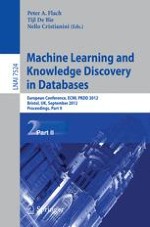2012 | OriginalPaper | Buchkapitel
Location Affiliation Networks: Bonding Social and Spatial Information
verfasst von : Konstantinos Pelechrinis, Prashant Krishnamurthy
Erschienen in: Machine Learning and Knowledge Discovery in Databases
Verlag: Springer Berlin Heidelberg
Aktivieren Sie unsere intelligente Suche, um passende Fachinhalte oder Patente zu finden.
Wählen Sie Textabschnitte aus um mit Künstlicher Intelligenz passenden Patente zu finden. powered by
Markieren Sie Textabschnitte, um KI-gestützt weitere passende Inhalte zu finden. powered by
Location-based social networks (LBSNs) have recently attracted a lot of attention due to the number of novel services they can offer. Prior work on analysis of LBSNs has mainly focused on the social part of these systems. Even though it is important to know how different the structure of the social graph of an LBSN is as compared to the friendship-based social networks (SNs), it raises the interesting question of what kinds of linkages exist between locations and friendships. The main problem we are investigating is to identify such connections between the social and the spatial planes of an LBSN. In particular, in this paper we focus on answering the following general question “What are the bonds between the social and spatial information in an LBSN and what are the metrics that can reveal them?” In order to tackle this problem, we employ the idea of
affiliation networks
. Analyzing a dataset from a specific LBSN (Gowalla), we make two main interesting observations; (i) the social network exhibits
signs of homophily
with regards to the “places/venues” visited by the users, and (ii) the “nature” of the visited venues that are common to users is powerful and informative in revealing the social/spatial linkages. We further show that the “entropy” (or diversity) of a venue can be used to better connect spatial information with the existing social relations. The entropy records the diversity of a venue and requires only location history of users (it does not need temporal history). Finally, we provide a simple application of our findings for predicting existing friendship relations based on users’ historic spatial information. We show that even with simple unsupervised learning models we can achieve significant improvement in prediction when we consider features that capture the “nature” of the venue as compared to the case where only apparent properties of the location history are used (e.g., number of common visits).
